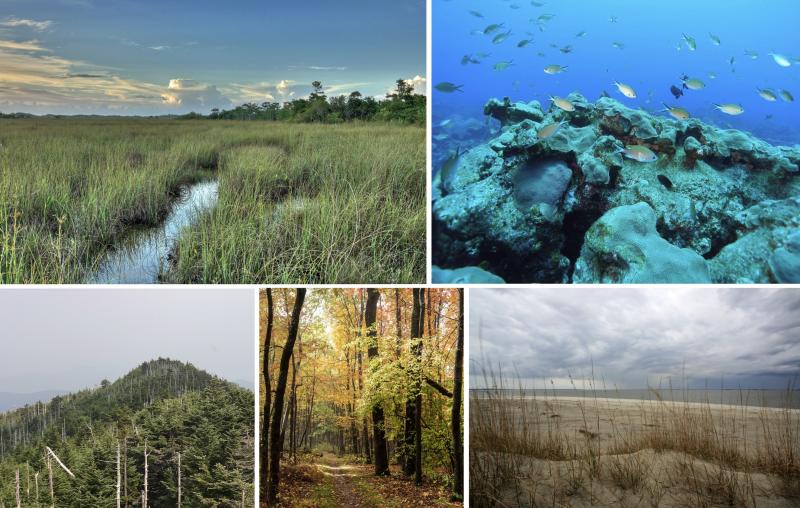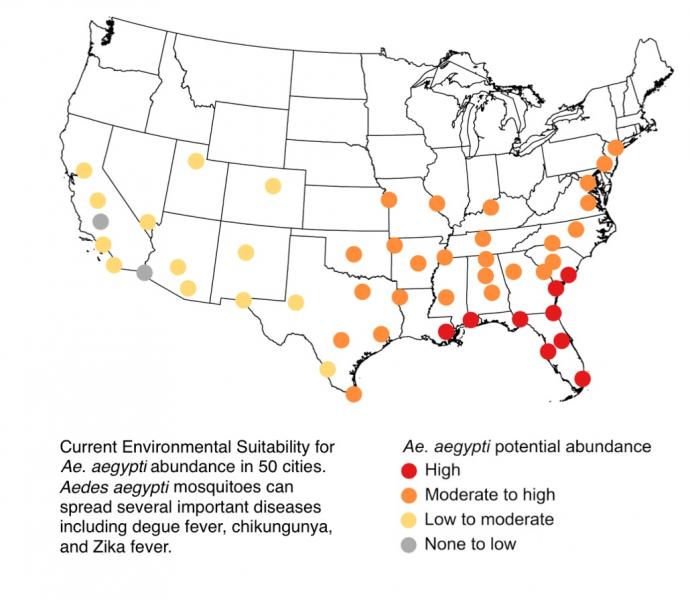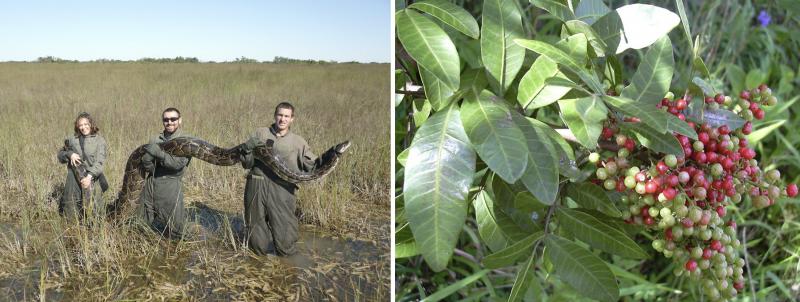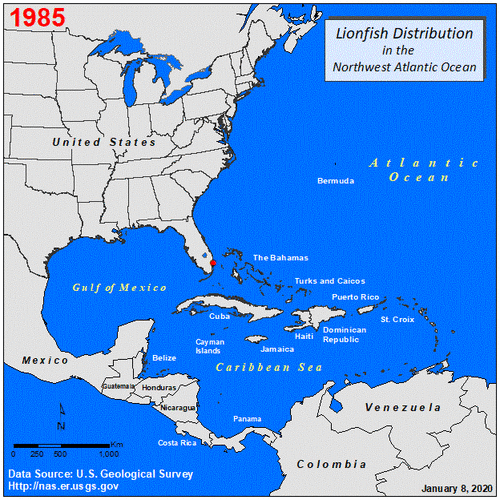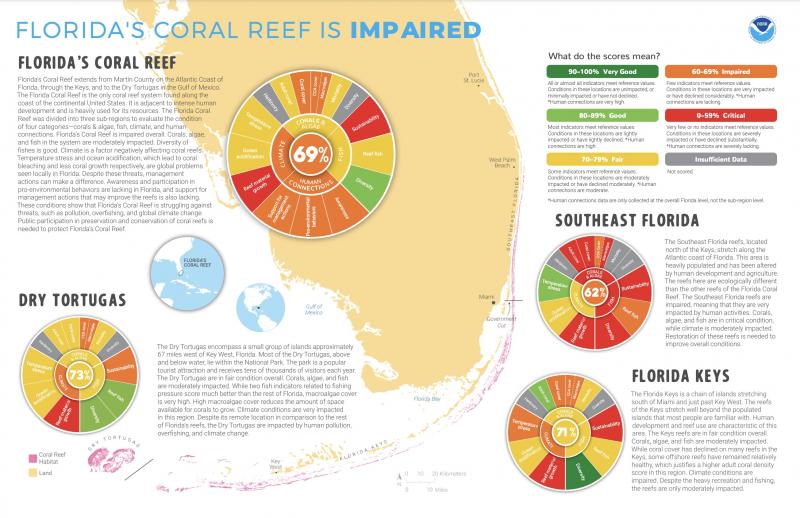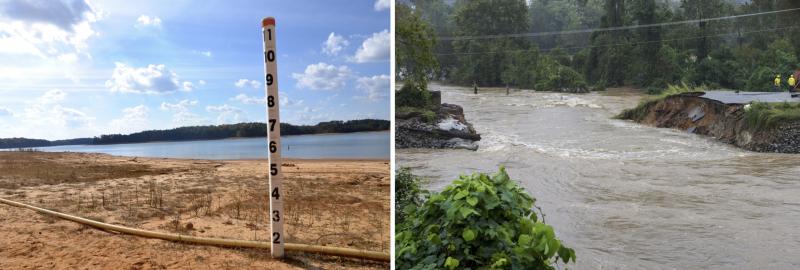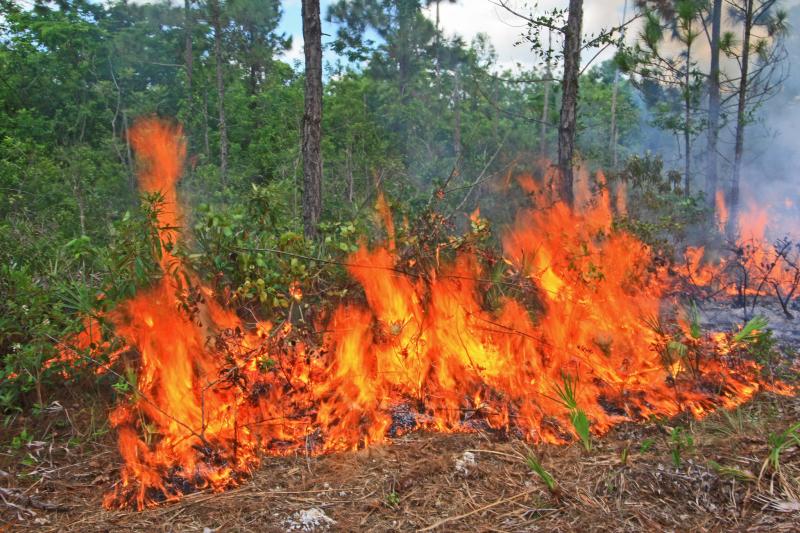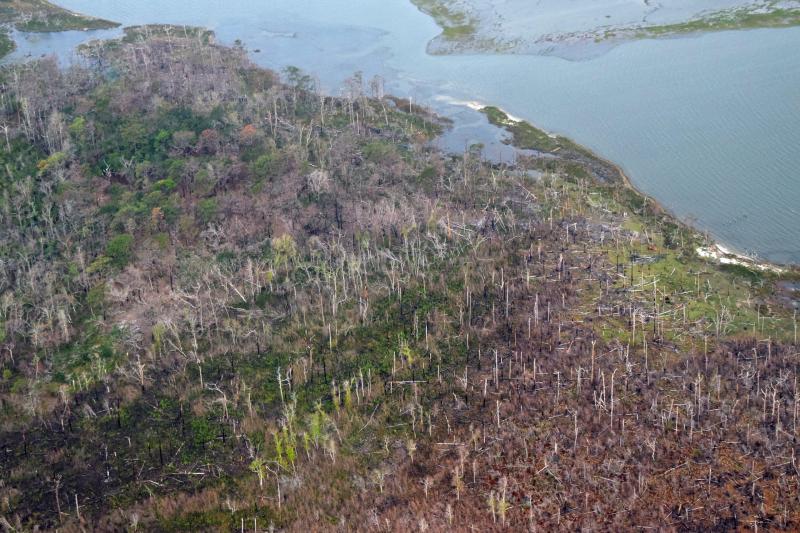Ecosystems Impacts
Natural ecosystems are responding to climate change
Ecological resources that people in the Southeast region depend on for their livelihoods, protection, and well-being are increasingly at risk from climate-related hazards. Changing temperature extremes, wildfire patterns, sea level rise, hurricanes, floods, droughts, and warming ocean temperatures have already redistributed species and modified ecosystems, and they will continue to do so.
Ecosystems in the Southeast span the transition zone between tropical and temperate climates. The region’s more temperate ecosystems include hardwood forests, spruce-fir forests, pine-dominated forests, and salt marshes. The region’s more tropical ecosystems include mangrove forests, coral reefs, pine savannas, and the tropical freshwater wetlands of the Everglades.
In addition to providing habitat for fish and wildlife, the diverse ecosystems provide significant environmental and socioeconomic services. Environmental services include improving water quality, carbon sequestration, supporting food webs, and reducing erosion. The socioeconomic services derived from these ecosystems include recreational and tourism opportunities, productive seafood and timber markets, and reduced flood impacts from storm surge and rain events.
Changes in the past, changes in the future
Climate change is already impacting ecosystems through changes in species ranges and behavior. For example, the northern range edge of mangroves, a tropical species of trees that grow in the coastal zone, is pushing into and replacing the southern edge of salt marsh, a temperate species, in Northeast Florida. These changes have been documented by ecologists who examined aerial photos of the region over time. Another species on the move is an intertidal mussel that has shifted from Cape Hatteras, North Carolina, to Lewes, Delaware, over 50 years. This change occurred due to increasing summer temperatures, according to scientists who conducted field experiments. As warm spring temperatures arrive earlier, the timing of flowering plants and growing seasons of crops are shifting. And warmer winter temperatures are leading to the spread of disease-carrying vectors such as mosquitoes carrying the Zika virus. Indeed, ecologists have begun using the term "tropicalization" to describe the transformation of temperate ecosystems by poleward‐moving tropical organisms in response to warming temperatures.1
In the coming decades and centuries, climate change will continue to transform ecosystems in the region. We will see continued range shifts of species and ecosystems, as well as species extinctions, on land as well as in coastal waters. Currently, coral reefs in Florida are considered “impaired”—as water temperatures increase, they are at risk of further bleaching and die-offs. These changes may reduce the societal and economic benefits these ecosystems provide, and permit the establishment of other ecosystems.
Warming winters
If heat-trapping carbon emissions continue increasing through the end of this century (a scenario called higher emissions or RCP 8.5), the duration of the freeze-free season in the Southeast is expected to lengthen by more than a month. As fewer cold events occur, tropical and subtropical species currently restricted by freeze events could expand northward. Thus, warmer winters have the potential to transform current ecosystems and landscapes, including the plants and crops that gardeners and farmers can grow.
Warming creates new habitat for invasive species
Some problematic invasive species—the Burmese python and the Brazilian pepper tree, for example—could move further north with warming winter temperatures. Warmer winter air temperatures will also affect the movement and interactions between other organisms. For example, certain insect species, including mosquitoes and tree-damaging beetles, are expected to move northward in response to climate change, which could affect human health and timber supplies.
In response to milder winters, some bird species are not expected to migrate as far south as they once did, and this could affect recreational opportunities for birding and hunting. Fewer birds migrating to the southeastern U.S. could impact other species of plants and insects that rely on these migrating bird species to help pollinate plant species and keep certain pests under control.
Warming ocean temperatures
Marine and coastal ecosystems are changing in response to warming waters. Many species are sensitive to small changes in ocean temperature, so their distribution and abundance are expected to change as ocean temperatures increase. For example, the distribution of tropical herbivorous fish has been expanding northward in response to warmer waters, and this migration is accompanied by decreases in the cover of valuable macroalgal plant communities. In the coming decades, warming ocean temperatures are expected to transform many marine and coastal ecosystems across the Southeast.
In coastal waters, the well-known lionfish, a carnivorous tropical fish native to the Indo-Pacific, is now a flourishing invasive species in coastal waters of the Southeast and Caribbean, and warming water temperatures will allow for its northward expansion up the coast. Watch the animation to see how the distribution expanded, especially in the early 2010s. You can learn more about the spread of invasive species in the United States at the USGS Nonindigenous Aquatic Species site. The site includes access to Flood and Storm Tracker (FaST) maps, created to help assess how nonindigenous aquatic species may spread via flooding associated with tropical storms that have impacted the Southeast.
The impacts to coral reef ecosystems in the region have been and are expected to continue to be particularly dire. Coral reefs provide coastal protection from waves, essential fish habitat, and recreational and tourism opportunities. However, coral reef mortality in the Florida Keys and across the globe has been very high in recent decades, due in part to warming ocean temperatures, nutrient enrichment, disease, overfishing, and coastal development. In their annual status updates, NOAA's National Coral Reef Monitoring Program reports that a growing majority of Florida's coastal coral reef ecosystems are impaired. Small increases in ocean temperature can “bleach” corals, a process in which corals expel the algae upon which they depend for nourishment. When this happens, corals lose their color and can die. Coral in the Florida Keys has been declining in recent decades, and present-day temperatures in the region are already close to bleaching thresholds; hence, it is likely that many of the remaining coral reefs in the Southeast region will be lost in the coming decades. For more information on the value, threats, and protection of coral reefs, explore Voices from Florida's Changing Coral Reefs »
Many recreational fishery populations are freeze-sensitive; therefore, as fewer freeze events occur, these populations are expected to move northward. Although anglers may welcome the arrival of tropical recreational fish (snook, for example) further north, the movement of tropical marine species is expected to greatly modify existing food webs and ecosystems. For instance, commercial fishers and recreational fishing charters may not find fish species where they traditionally have occurred, reducing catch for commercial fishers and busting recreational charters that come up short or empty on targeted fish species.
Warming seas may also impact the timing and areas where marine species reproduce, potentially impacting their overall abundances in traditionally fished areas. One observed result of warming waters is the skewing of the sex ratio of sea turtles: females develop in warmer temperatures while males develop in cooler temperatures, so more females are developing. Additionally, a decrease in the growth of sea turtles in the western Atlantic has been linked to higher ocean temperatures.
Climate change will also shift the direction and intensity of major currents through changing ocean temperatures. Major currents such as the Florida Current and Gulf Stream transport warm water northward, and these currents serve to transport marine species of all life stages. Changes in these currents will be particularly problematic for species living on the ocean floor, as they depend on the warmer waters and associated food resources. Deep sea explorations in areas that were historically parts of major currents have found huge losses of species and biodiversity when those currents shift to new areas.
Drought and extreme rainfall
Climate change is expected to make rainfall extremes—both drought and heavy precipitation—more common in the Southeast. Drought and extreme heat can result in tree mortality, giving new species opportunities to move into an area.
Drought can also affect aquatic and wetland ecosystems in salt marshes, mangrove forests, and tidal freshwater forests by limiting the amount of freshwater to these systems and increasing saltwater intrusion. Elevated salinity levels cause crop yield declines, coastal forest loss, increases in salt-tolerant invasive species, eutrophication, and marsh migration. Vegetation stressed by salinization is more susceptible to mortality by events such as droughts, hurricanes, and fires. Salinity and salinization can also cause clay dispersion that reduces soil drainage capacity, increases nutrient release that can lead to algal blooms and fish mortality, and degraded groundwater for irrigation.
Extreme rainfall events are also expected to become more frequent and severe in the future. The prolonged inundation that results from extreme rainfall can lead to the dieback of critical plant species.
In combination, increases in extreme drought and extreme rainfall are expected to transform many natural systems in the Southeast region. These ecosystems will have to become resistant and resilient to both too little water and too much water. The ecological transformations induced by these extreme events are likely to reduce many of the benefits that natural systems currently provide.
Changing patterns of fire
Fire has historically played an important role in the Southeast, and ecological diversity in many southeastern natural systems is dependent upon fire. Although the total area burned by wildfire is greatest in the western United States, the Southeast has the highest number of wildfires each year. However, this region also has the largest forest area managed by prescribed fire, which helps maintain or restore healthy forest habitats and prevent or reduce large wildfires.
Changes in the frequency, intensity, size, pattern, season, and severity of wildfires—factors that define a region’s fire regime—are expected to have a large impact on natural systems in the Southeast. In the future, rising temperatures and increases in the duration and intensity of drought are expected to increase wildfire occurrence and also reduce the effectiveness of prescribed fire. Moreover, rapid urban expansion near managed forests has the potential to reduce opportunities to use prescribed fire, which could lead to native species declines, increased wildfire occurrence, and economic and health impacts.
In the fall of 2016, much of the Southeast region was under extreme to exceptional drought conditions. This drought, along with high temperatures and increases in accumulated plant material on the forest floor, resulted in the worst wildfires the region has seen in a century. Between October and November, at least 33 wildfires burned over 90,000 acres in Alabama, Georgia, North Carolina, South Carolina, and Tennessee. Droughts are expected to become more frequent in the future, leading to greater fire activity that will continue transforming forest ecosystems in the region.
Hurricanes and coastal storms
North Atlantic hurricane activity has increased since the 1970s, and the intensity of these storms and the rate of precipitation associated with them are projected to increase in the future. In the 2010s, many of the landfalling storms moved more slowly than in previous decades, producing significant amounts of rainfall that caused extensive riverine and coastal flooding. Landfalling storms also bring storm surge, which can result in major shoreline erosion and disrupt coast ecosystems by submerging them in seawater. See Coastal Impacts for further information.
Rising sea levels
Freshwater and land-based ecosystems along the coast are highly sensitive to increases in inundation and salinity. Rising sea levels will convert many of these systems to tidal saline habitats, affecting the nature of plants and animals that can exist there. As sea level rises, more and more saltwater encroaches on the land. Along the Southeast's coasts and estuaries, invading seawater advances and overtakes the fresh water that deciduous trees rely upon for sustenance. The salty water slowly poisons living trees, leaving a haunted ghost forest of dead and dying timber.
Historically, coastal ecosystems have adjusted to sea level rise by vertical and horizontal movement across the landscape. As current rates of sea level rise accelerate, some coastal ecosystems such as seagrasses, mangroves, and marshes will be submerged and converted to open water. Additionally, saltwater intrusion into groundwater will allow salt-tolerant coastal ecosystems to move inland at the expense of existing inland and upriver ecosystems.
Where barriers such as levees and other coastal infrastructure are present (e.g., roads, homes), the potential for landward migration of natural systems is reduced. In this case, coastal habitats for mangroves and salt marshes may be lost—a phenomenon known as coastal squeeze. For more information, see Rising Tide: Will Climate Change Drown Coastal Wetlands?
Responding to rising sea level in Louisiana
People in Louisiana gain numerous benefits from the ecosystems of the Mississippi River Delta, including a thriving seafood industry, hurricane storm protection, water supply, and waste treatment. However, the state faces some of the highest land loss rates in the world. Between 1932 and 2016, Louisiana lost more than 2,000 square miles of land area (almost the size of Delaware) due in part to high rates of relative sea level rise. Louisiana will continue to lose coastal wetlands over time.
Recognizing the threat of land loss and its impact to the nation’s economy, Louisiana Coastal Protection and Restoration Authority is working with local, state, and federal partners to implement its Coastal Master Plan. The plan lays out a 50-year, $50-billion restoration and protection strategy to sustain Louisiana’s coastal ecosystems, safeguard coastal populations, and protect vital economic and cultural resources.
To learn more about how climate change is affecting land-based and marine ecosystems, visit the Ecosystems or Marine topics.
- 1Osland, M.J., P.W. Stevens, M.M. Lamont, R.C. Brusca, K.M. Hart, J.H. Waddle, C.A. Langtimm, C.M. Williams, B.D. Keim, A.J. Terando, E.A. Reyier, K.E. Marshall, M.E. Loik, R.E. Boucek, A.B. Lewis, and J.A. Seminoff, 2021. Tropicalization of temperate ecosystems in North America: The northward range expansion of tropical organisms in response to warming winter temperatures. Global Change Biology, https://doi.org/10.1111/gcb.15563.
